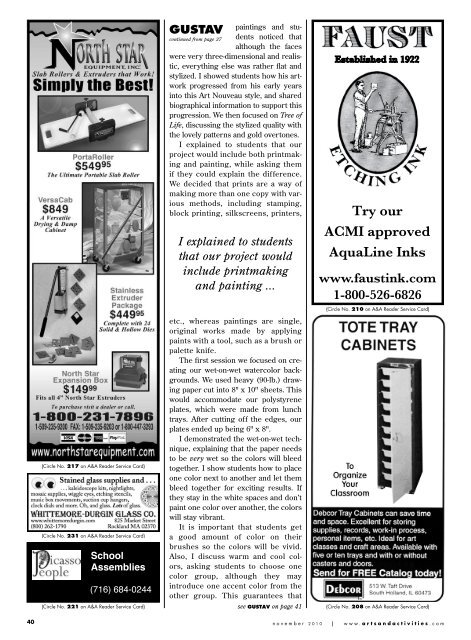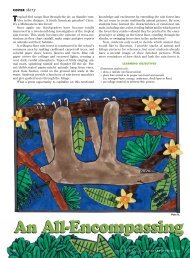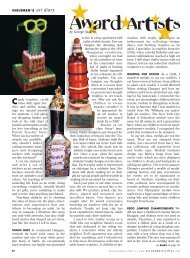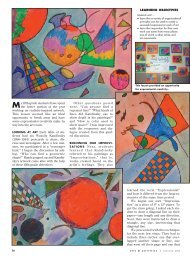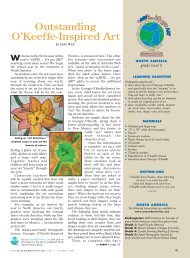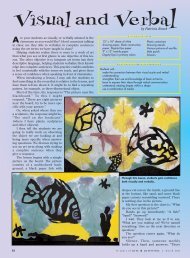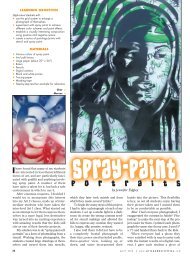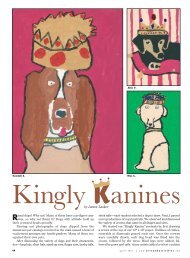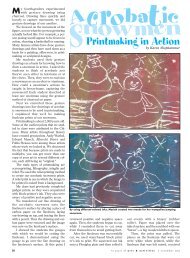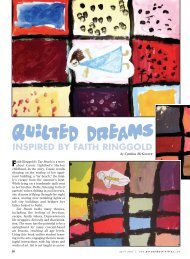Tree of Life: Gustav with Gusto - Arts & Activities Magazine
Tree of Life: Gustav with Gusto - Arts & Activities Magazine
Tree of Life: Gustav with Gusto - Arts & Activities Magazine
Create successful ePaper yourself
Turn your PDF publications into a flip-book with our unique Google optimized e-Paper software.
(Circle No. 217 on A&A Reader Service Card)<br />
(Circle No. 231 on A&A Reader Service Card)<br />
School<br />
Assemblies<br />
(716) 684-0244<br />
(Circle No. 221 on A&A Reader Service Card)<br />
GUSTAV<br />
continued from page 37<br />
paintings and students<br />
noticed that<br />
although the faces<br />
were very three-dimensional and realistic,<br />
everything else was rather flat and<br />
stylized. I showed students how his artwork<br />
progressed from his early years<br />
into this Art Nouveau style, and shared<br />
biographical information to support this<br />
progression. We then focused on <strong>Tree</strong> <strong>of</strong><br />
<strong>Life</strong>, discussing the stylized quality <strong>with</strong><br />
the lovely patterns and gold overtones.<br />
I explained to students that our<br />
project would include both printmaking<br />
and painting, while asking them<br />
if they could explain the difference.<br />
We decided that prints are a way <strong>of</strong><br />
making more than one copy <strong>with</strong> various<br />
methods, including stamping,<br />
block printing, silkscreens, printers,<br />
I explained to students<br />
that our project would<br />
include printmaking<br />
and painting ...<br />
etc., whereas paintings are single,<br />
original works made by applying<br />
paints <strong>with</strong> a tool, such as a brush or<br />
palette knife.<br />
The first session we focused on creating<br />
our wet-on-wet watercolor backgrounds.<br />
We used heavy (90-lb.) drawing<br />
paper cut into 8" x 10" sheets. This<br />
would accommodate our polystyrene<br />
plates, which were made from lunch<br />
trays. After cutting <strong>of</strong>f the edges, our<br />
plates ended up being 6" x 8".<br />
I demonstrated the wet-on-wet technique,<br />
explaining that the paper needs<br />
to be very wet so the colors will bleed<br />
together. I show students how to place<br />
one color next to another and let them<br />
bleed together for exciting results. If<br />
they stay in the white spaces and don’t<br />
paint one color over another, the colors<br />
will stay vibrant.<br />
It is important that students get<br />
a good amount <strong>of</strong> color on their<br />
brushes so the colors will be vivid.<br />
Also, I discuss warm and cool colors,<br />
asking students to choose one<br />
color group, although they may<br />
introduce one accent color from the<br />
other group. This guarantees that<br />
see GUSTAV on page 41<br />
Established in 1922<br />
Try our<br />
ACMI approved<br />
AquaLine Inks<br />
www.faustink.com<br />
1-800-526-6826<br />
(Circle No. 210 on A&A Reader Service Card)<br />
(Circle No. 208 on A&A Reader Service Card)<br />
40<br />
november 2010 x www.artsandactivities.com


